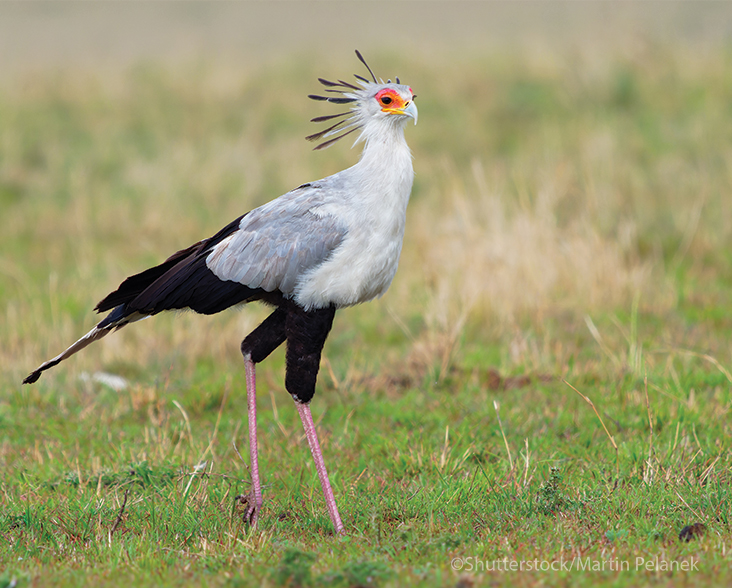Secretarybird
Species Data
Class: Aves
Order: Accipitriformes
Family: Sagittariidae
Scientific Name: Sagittarius serpentarius
IUCN Red List status: Endangered
DESCRIPTION
A large and unmistakable raptor, the monotypic Secretarybird measures 125-150 cm from bill to tail tip, has a wingspan of over 2 m, and stands 1.2 m tall on long pink legs. The plumage is pale blue-grey above and greyish-white below, with contrasting black remiges, rump, lower belly, rear flanks and ‘shorts’, long black erectile nape feathers, and white uppertail coverts. The graduated grey tail has a broad black subterminal band with white terminal tips and much longer central tail feathers, which together with the relatively long extended neck, give a distinctive flight silhouette. The bare yellow-orange to orange-red face merges into the blue-grey or yellow cere of the hooked blue-grey bill, and the iris is brown. The scales on the legs are heavier at the front to protect them when tackling prey.
Adults are similar in appearance, with females being slightly larger and less blue-tinged. Juveniles can be differentiated by their yellower face, black bill, grey eyes, shorter crest and tail, and grey barring on white underwing coverts and undertail coverts.
BEHAVIOUR
Secretarybirds are largely nomadic, spending much of the day walking up to 20 km (12.43 miles) searching for prey, usually in pairs or family groups, spaced some distance apart and hunting independently. Insects comprise 86% of their diet, with small rodents, shrews, hedgehogs, mongooses, squirrels, meerkats, small birds, amphibians, freshwater crabs, tortoises, lizards, and snakes, including venomous species such as puff-adders and cobras, amongst the prey also taken. Prey is immobilised by kicking and stamping with their feet before picking it up with the bill, with small prey swallowed whole and larger prey first torn up.
During the hottest part of the day, Secretarybirds often use rising thermals to soar as high as 3,800 m to cool off or move to another area within their territory, which ranges from 20-70 km2 in size, depending on the habitat. In the late afternoon, pairs return to their roost site in the canopy of a tree or an old nest.
Breeding can occur throughout the year, although typically timed so chicks fledge during the wet season when food is most plentiful. Courtship includes undulating aerial displays high above the nest area, stalling and swooping down with closed wings before opening again to regain height. Both sexes build the large flattened stick nest, 1-2.5 m across and 30-50 cm deep, and lined with grass, small sticks, wool, animal dung and leaves, situated 3-7.5 m high in the trampled canopy of a thorny tree such as an acacia. Both parents share incubation of the 1-3 eggs, starting when the first egg is laid and lasting 42-46 days. The chicks are fed by both parents, fledging at 65-106 days, after which they remain dependent on their parents. Fledglings can catch their own prey at around two weeks and join their parents on foraging trips at around 4-8 weeks after leaving the nest.


HABITAT
The Secretarybird occurs in open grasslands and savannas, preferring areas with scattered acacia trees and where the grassis less than 50 cm in height, including dry steppes, moist grasslands, sparsely wooded savanna, as well as large-scale cereal farmland and sub-desert, ranging from sea level to 3,000 m.
This species is distributed throughout sub-Saharan Africa from southern Mauritania in the west to north-western Somalia in the east and southwards through East Africa to southern Central Africa and Southern Africa. This species is absent from the Congo Basin and much of West Africa.
THREATS AND CONSERVATION
Although widespread and locally common in some areas, this species appears to be declining rapidly in parts of its range. Therefore, the Secretarybird is listed as Endangered on the IUCN Red List. Threats include habitat loss and degradation due to afforestation of grasslands, land conversion, overgrazing by livestock, and encroaching woody vegetation onto grasslands in South Africa. Other threats include increasing droughts due to climate change, reduced prey availability from excessive burning of grasslands, hunting, increased nest-raiding by humans, capture for the illegal wildlife trade, poisoning from pesticides, and collisions with fences and power cables.
Conservation measures include increasing protected areas within this species’ range, working with landowners to manage properties sustainably for this species, raising awareness of the threats amongst local people, and combating capture and trade.
